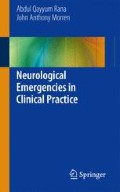Abstract
Delirium or acute confusional state is characterized by a fluctuating level of consciousness with impairment of attention, perception, and thinking. Four primary features include disturbance of consciousness, disturbance of cognition, limited course, and external causation. In the initial assessment of patients, one should provide reorientation and reassurance. If the patient is agitated, physical restraints should be avoided as much as possible. In obtaining the history, details about psychotropic medications and medical conditions especially renal and liver impairment are important. Alcohol and drug use should be ascertained. The examination should evaluate for signs of meningism, neurological focality, and cutaneous manifestations of infectious etiologies. Pupillary findings may be useful in implicating drug/toxic effects. Initial labs should always include urinalysis and if a fever is present, urine blood cultures and sensitivities. Further work-up may involve head imaging, lumbar puncture, and EEG. Specific treatment depends on the underlying cause and often involves cessation of offending medications, treatment of underlying infections, or metabolic/electrolyte disturbances. Active orientation strategies may be helpful especially in patients with “sundowning.” In the elderly, delirium is associated with increased mortality of up to 40 % in 1 year after hospital discharge.
Access this chapter
Tax calculation will be finalised at checkout
Purchases are for personal use only
References
Deksnytė A, Aranauskas R, Budrys V, Kasiulevičius V, Sapoka V. Delirium: its historical evolution and current interpretation. Eur J Intern Med. 2012;23(6):483–6.
Balas MC, Rice M, Chaperon C, Smith H, Disbot M, Fuchs B. Management of delirium in critically ill older adults. Crit Care Nurse. 2012;32(4):15–26.
Siddiqi N, House AO, Holmes JD. Occurrence and outcome of delirium in medical in-patients: a systematic literature review. Age Ageing. 2006;35(4):350–64.
Wass S, Webster PJ, Nair BR. Delirium in the elderly: a review. Oman Med J. 2008;23(3):150–7.
Author information
Authors and Affiliations
Rights and permissions
Copyright information
© 2013 Springer-Verlag London
About this chapter
Cite this chapter
Rana, A.Q., Morren, J.A. (2013). Delirium. In: Neurological Emergencies in Clinical Practice. Springer, London. https://doi.org/10.1007/978-1-4471-5191-3_2
Download citation
DOI: https://doi.org/10.1007/978-1-4471-5191-3_2
Published:
Publisher Name: Springer, London
Print ISBN: 978-1-4471-5190-6
Online ISBN: 978-1-4471-5191-3
eBook Packages: MedicineMedicine (R0)

